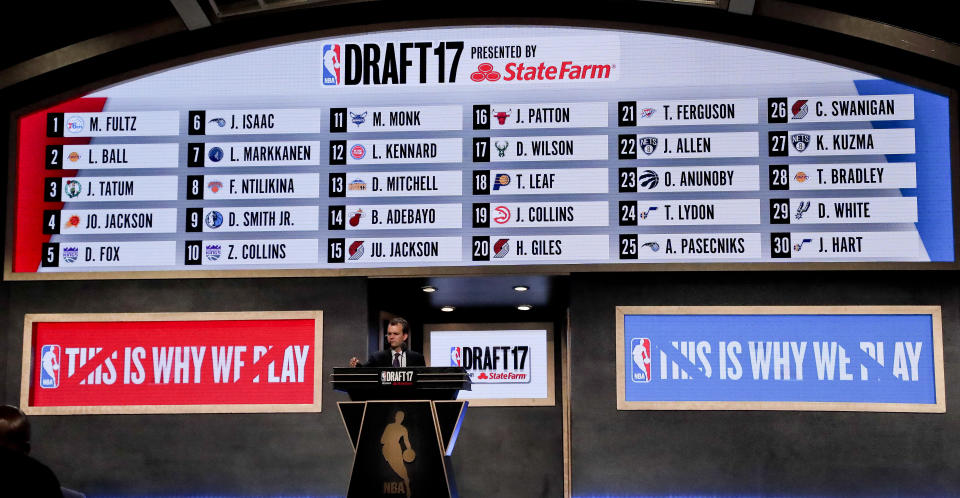NBA approves draft lottery reform, player rest guidelines

In the NBA’s latest effort to curb tanking, the league’s Board of Governors passed measures in New York on Thursday that will both reform the draft lottery and institute guidelines to discourage teams from resting healthy players during the regular season, the league confirmed in a press release.
ESPN’s Adrian Wojnarowski first reported the news.
NBA commissioner Adam Silver supported both changes in an attempt to prevent teams from resting multiple starters, particularly teams blatantly trying to lose more games and improve draft position.
[Now’s the time to sign up for Fantasy Basketball! Join for free]
The draft changes — which expand the number of picks in the lottery from three to four, even the odds for teams with the three worst records and smooth out the declining odds from there on out — received the necessary 23 votes from the NBA’s 30 owners and will be enacted for the 2019 draft.
“I felt lottery reform was important because there was a perception in many of our communities that the best path to rebuilding their teams was to race to the bottom,” said Silver. “I don’t necessarily agree that’s the optimal strategy to create a great team, but it became currency in this league. So much so that there were situations in many of our communities where the team felt under pressure to engage in that strategy, even when they didn’t think that was the best strategy to build their team.”
Under the old system, the 14 non-playoff teams each had a chance at a top-three pick. The worst five teams had 25 percent, 19.9 percent, 15.6 percent, 10.4 percent and 10.3 percent odds at the No. 1 overall pick, respectively. And there was a significant drop-off in odds for the remaining nine teams.
Now, all lottery teams have a shot at a top-four pick, teams with the worst three records each have 14 percent odds at the top pick, and the odds drop no more than two percent for each successive team.
Here is an ESPN graphic on how NBA Draft lottery odds change in 2019 pic.twitter.com/Jk8X7q0J3Z
— Adrian Wojnarowski (@wojespn) September 28, 2017
The league rejected a similar proposal in 2014. However, the 76ers’ “Process” — years of tanking that resulted in lottery picks Joel Embiid, Ben Simmons and Markelle Fultz, among others, in Philadelphia — appeared to be a catalyst for change, despite reported concern by a number of small-market teams that already struggle to rebuild through free agency and fear lottery reform will exacerbate the issue.
“There is no question that the analytics were suggesting that a plausible strategy was to be bad,” Silver told a gathering of reporters following two days of meetings in New York. “Not to suggest they were intentionally losing games, but to be bad. To trade away otherwise very serviceable players and embark on a strategy that requires them to, in essence, field poor teams, which they believed would give them the best chance to improve over the long term. I felt it was corrosive to this league.”
Sources: The NBA's draft lottery reform passed 28-1-1. Oklahoma City voted "No" and Dallas abstained. NBA needed 3/4th majority for passage.
— Adrian Wojnarowski (@wojespn) September 28, 2017
How much these changes will actually prevent tanking remains up for debate. There is still incentive to drop to the bottom three in the standings, and increased odds later in the lottery could lead teams that might otherwise compete for a seventh or eighth seed in the playoffs to drop into the lottery.
[Follow Ball Don’t Lie on social media: Twitter | Instagram | Facebook | Tumblr]
That’s where the rest rules come in, hopefully.
The new rules regarding player rest, which required a majority vote from the board, reportedly encourage teams not to rest players for national TV games and to only rest healthy players for home games. The league supposes fans in road cities and watching on TV have fewer opportunities to see stars on opposing teams than fans with access to as many as 41 home games per season.
“It ultimately is my hope that the rules go in the drawer and that teams step up here and see that there is a larger obligation to our fans, to the basketball community,” said Silver. “It’s connected to the lottery reform as well, to put their best product on the floor and create great competition.”
This is in clear response to back-to-back primetime games this past March, when the Golden State Warriors sat all of their stars against the San Antonio Spurs and the Cleveland Cavaliers sat their three stars against the Los Angeles Clippers. ABC commentators Mark Jackson and Jeff Van Gundy went so far as to call the resting issue “an absolute joke” and “a prosecutable offense” during the broadcast.
The guidelines now allow Silver to fine teams for resting multiple healthy starters on the same night, especially games broadcast by the league’s national TV partners, according to Wojnarowski. Star players are now also reportedly expected to interact with fans and sit on the bench when resting.
Hopefully, the new disciplinary measures are strict enough to prevent what the Phoenix Suns did last season, sitting a number of impact players down the stretch, including Eric Bledsoe, who publicly questioned the tactic. Suns coach Earl Watson ultimately dubbed it a “management decision,” and Phoenix dropped to the league’s second-worst record and, perhaps by karma, fell to No. 4 in the draft.
“Without commenting specifically on Phoenix, because every situation is different, I think you can look at our guidelines now on resting,” added Silver. “I think to the extent players are rested, to the extent players are rested for long periods of time, I think we’ll be looking to our guidelines and assessing whether those teams are acting in compliance with our rules.”
In another effort to limit the need for rest, the NBA lengthened its schedule by almost two weeks, limiting the number of back-to-back games and eliminating stretches of four games in five nights.
Needless to say, there are still some skeptics who question whether the new measures will curb the tanking issue. That seemed clear when Houston Rockets general manager Daryl Morey tweeted to ousted 76ers GM Sam Hinkie — the mastermind behind the “Process” — shortly after the league’s vote.
@samhinkie tanking is solved
— Daryl Morey (@dmorey) September 28, 2017
The reality is there’s no ideal solution to solve tanking, but at least the NBA is trying.
“What we did was a compromise, in effect,” said Silver, who conceded that the player rest guidelines, in particular, will need tinkering year over year. “I think what we’ve put in place is far from perfect.”
– – – – – – –
Ben Rohrbach is a contributor for Ball Don’t Lie and Shutdown Corner on Yahoo Sports. Have a tip? Email him at rohrbach_ben@yahoo.com or follow him on Twitter! Follow @brohrbach



